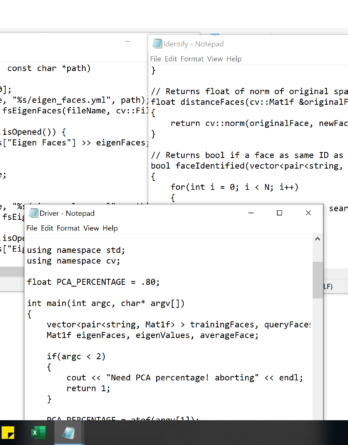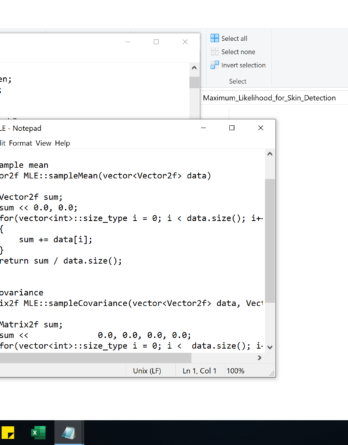Description
1. In the previous assignment, you designed a Bayes classifier assuming the following 2D
Gaussian distributions:
1
1
1
1
1 0
0 1
2
4
4
2
1 0
0 1
In this assignment, you will assume that you do not know the true parameters of the
Gaussian distributions and that you need to estimate them from the training data using
the Maximum Likelihood (ML) approach.
a. Using the same 200,000 samples from the previous assignment, estimate the
parameters of each distribution using ML. Then, classify all 200,000 samples
assuming P (ω1) = P (ω2); count the number of misclassified samples and compare
your results to those obtained in assignment 1.
b. Repeat experiment (1.a) using 1/100 of the samples from each distribution (randomly
selected) to estimate the parameters of that distribution using ML. Then, classify all
200,000 samples assuming P (ω1) = P (ω2); count the number of misclassified
samples and compare your results to those obtained in experiment (1.a).
2. Repeat problem 1 using the samples (same as in Assignment 1) from the following 2D
Gaussian distributions:
1
1
1
1
1 0
0 1
2
4
4
2
4 0
0 8
3. Face detection using skin color is a popular approach. While color images are typically
in RGB format, most techniques transform RGB to a different color space (e.g.,
chromatic, HSV, etc.). This is because RGB values are more sensitive to changes of
brightness due to illumination changes.
a. Implement the skin-color methodology of [Yang96 “A Real-time Face Tracker”]
which uses the chromatic color space. To build the skin color model, use
Training_1.ppm (and ref1.ppm), shown in Figure 1, which are available from the
course’s webpage. To test your method, use Training_3.ppm (and ref3.ppm) and
Training_6.ppm (and ref6.ppm), which are also available from the course’s
webpage. To quantitatively evaluate the performance of your method, generate
ROC plots (i.e., false positives (FP) vs false negatives (FN)) by varying the skincolor threshold. A FP would be a non-face pixel which was classified as skincolor while a FN would be a face pixel which was classified as non-skin color. To
compute the FPs and FNs for each test image, use the corresponding reference
images.
b. Repeat (3.a) using the YCbCr color space In the YCbCr color space, the
luminance information is contained in Y component; and, the chrominance
information is in Cb and Cr. Therefore, Y should not be used in the skin color
model. The RGB components can be converted to the YCbCr components using
the following transformation:
Y = 0.299R + 0.587G + 0.114B
Cb = -0.169R – 0.332G + 0.500B
Cr = 0.500R – 0.419G – 0.081B
Figure 1. Training_1.ppm and ref1.ppm images.
For comparison purposes, plot the ROC curves in the same graph.
Note: Irfanview is a nice tool for image display/manipulation. Sample code to read/write
color images in PPM format can be found in my CS 302 webpage:
http://www.cse.unr.edu/~bebis/CS302/
Information on the PPM image file format can be found here:
http://paulbourke.net/dataformats/ppm/
http://www.cse.unr.edu/~bebis/CS302/Lectures/IP.ppt




